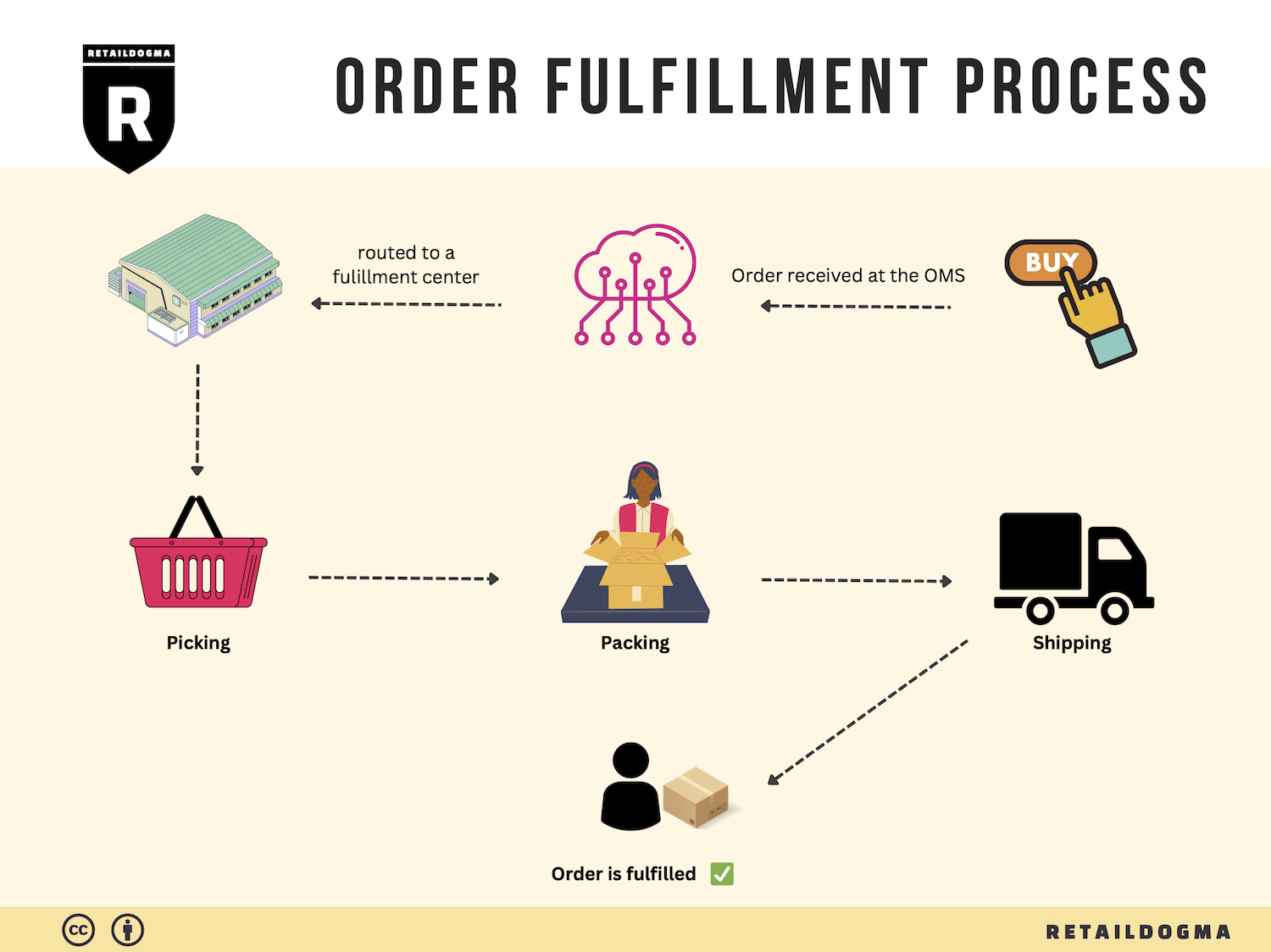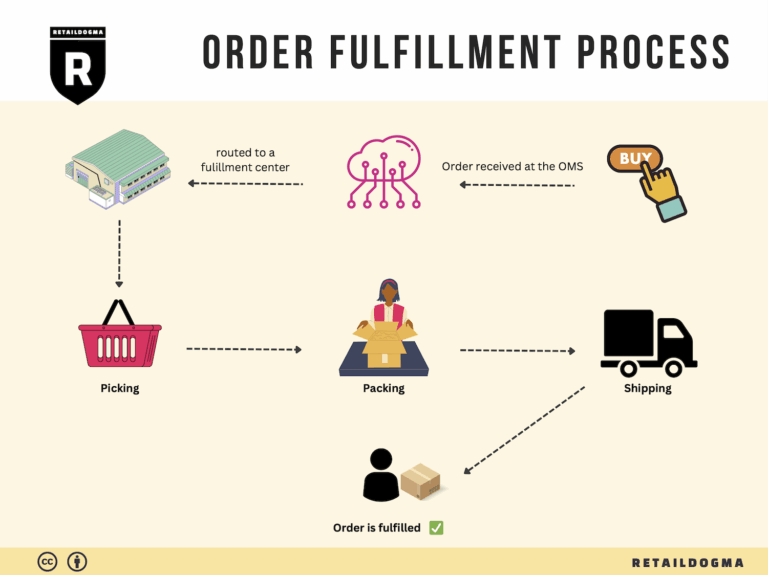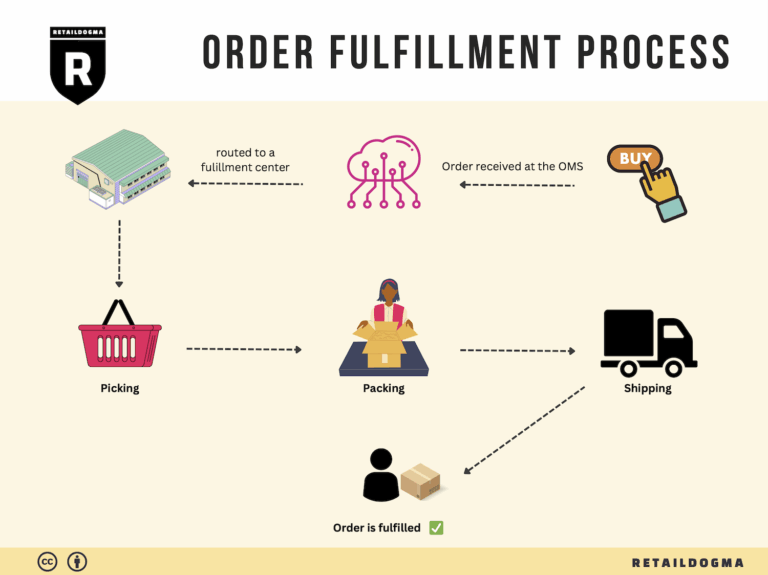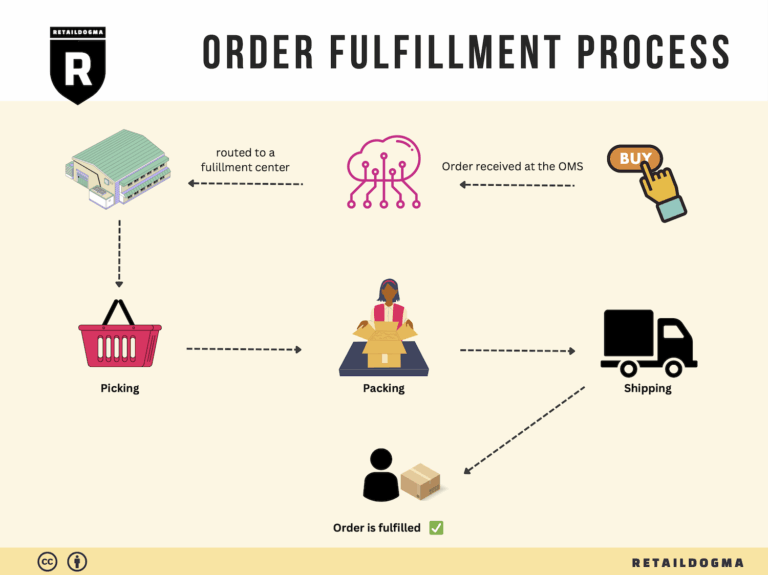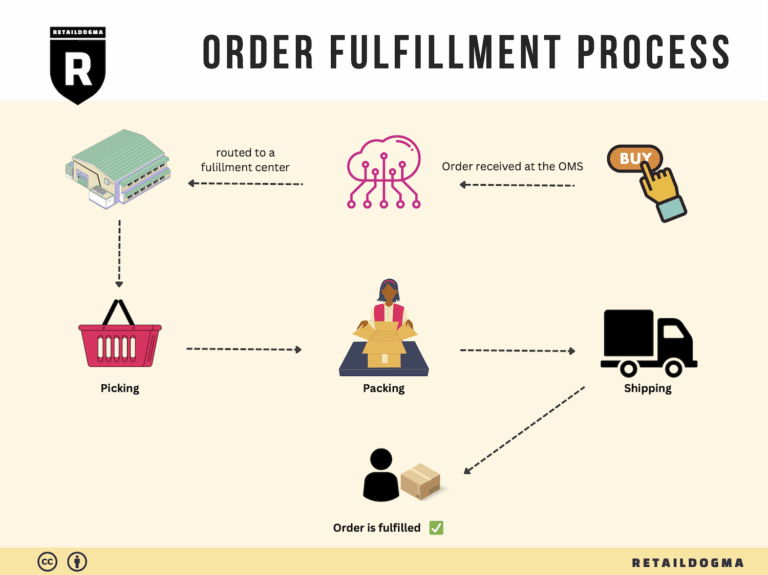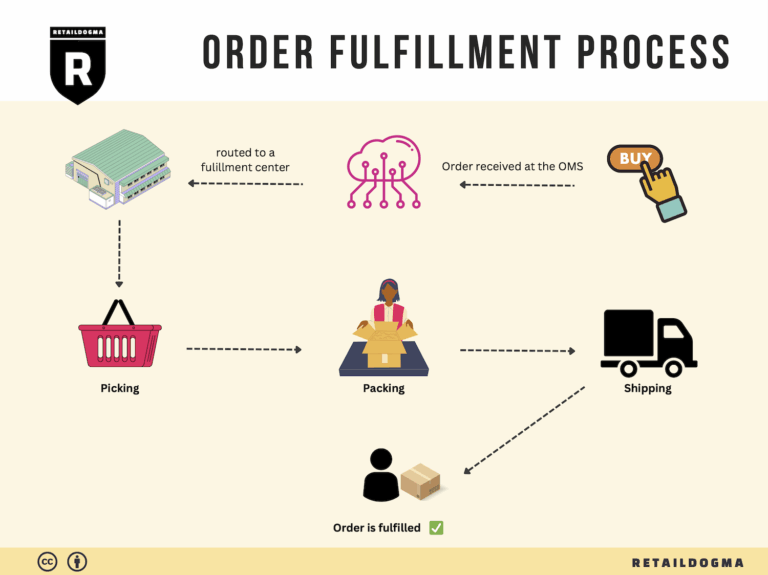Ecommerce Fulfillment Services: The Ultimate Guide (2025)
What is E-commerce Fulfillment? An Introduction for Growing Businesses
Understanding E-commerce Fulfillment: A Key to Scaling Your Business
As an e-commerce business owner, you might find yourself grappling with one of the most daunting challenges: managing the packing and shipping of orders. The excitement of growing sales can quickly turn into stress when faced with the logistics of fulfilling those orders efficiently and accurately. This is where e-commerce fulfillment comes into play. At its core, fulfillment is the process of getting a product from your warehouse to the customer’s doorstep. It encompasses everything from receiving inventory to processing orders, picking items, packing them securely, and finally shipping them out.
For many growing businesses, fulfillment can be a complicated landscape to navigate. With various models available, such as Third-Party Logistics (3PL) and Fulfillment by Amazon (FBA), it’s essential to understand the differences to find the best fit for your operations. This guide aims to clarify these models and the core services they offer, including inventory management, order processing, and shipping solutions.
In addition, choosing the right fulfillment partner is critical to your business’s success. Factors to consider include the partner’s technology capabilities, shipping speed, and customer service responsiveness. We will explore how to evaluate potential partners effectively, ensuring you select one that aligns with your business goals and customer expectations.
Pricing is another important aspect of fulfillment that can significantly impact your bottom line. Understanding the various costs involved—such as storage fees, picking and packing charges, and shipping rates—will empower you to make informed decisions that optimize your logistics without sacrificing quality.
Ultimately, this guide is designed to equip you with the knowledge and tools necessary to navigate the complexities of e-commerce fulfillment. Our goal is to empower you to make smart, strategic decisions about your logistics operations, enabling you to focus on what you do best—growing your business and delighting your customers. With the right fulfillment strategy in place, you can streamline your operations, improve customer satisfaction, and scale your sales effectively.
What You’ll Learn In This Guide
- What is E-commerce Fulfillment? An Introduction for Growing Businesses
- The Order Fulfillment Process: From ‘Buy’ Button to Customer’s Door
- Comparing Fulfillment Models: In-House vs. 3PL vs. Dropshipping
- A Deep Dive into Amazon FBA: Pros, Cons, and Who It’s For
- Core Services Offered by Fulfillment Centers
- How to Choose a Fulfillment Partner: A 6-Point Checklist
- Understanding Fulfillment Pricing: A Breakdown of Common Fees
- Frequently Asked Questions (FAQs) about Fulfillment
- Conclusion: Is Outsourcing Fulfillment the Right Move for Your Business?
- Important Disclaimer
The Order Fulfillment Process: From ‘Buy’ Button to Customer’s Door
1. Receiving Inventory
The order fulfillment process begins with receiving inventory at the fulfillment center. This step involves the systematic intake of products from suppliers or manufacturers, ensuring that items match the purchase orders in terms of quantity and quality. Key metrics such as Stock Keeping Units (SKUs) are crucial at this stage, as they allow for the accurate tracking of each item.
Once the inventory is received, it’s inspected for damages and discrepancies. Proper documentation is essential, as it provides a record of what has been received and helps manage stock levels. This step is vital for maintaining an accurate inventory count and prevents stockouts or overstock situations, which can disrupt order fulfillment.
2. Warehouse Storage
After receiving the inventory, the next step is warehouse storage. This involves organizing and storing the products in designated areas within the fulfillment center. Efficient storage systems are critical here; utilizing methods such as FIFO (First In, First Out) or LIFO (Last In, First Out) ensures that older stock is sold first, reducing the risk of product obsolescence.
Effective warehouse layout and management directly impact retrieval speed and overall efficiency. Products are often categorized and placed based on their popularity and size, allowing for a streamlined picking process. This step is essential for maximizing space and ensuring that items are easily accessible when orders are placed.
3. Order Picking
Once an order is received, the next phase is order picking, where warehouse staff retrieve the necessary items from storage. This step is guided by pick lists, which detail the specific products needed for each order. These lists can be generated manually or through automated systems, depending on the sophistication of the fulfillment center.
Order picking is a critical process that directly affects order accuracy and fulfillment speed. The use of technology, such as barcode scanners, can enhance efficiency and reduce errors. Proper training of staff in picking techniques can also lead to faster order processing times. This step is crucial for ensuring that customers receive the correct items promptly, which directly impacts customer satisfaction.
4. Order Packing
Once the items have been picked, they move on to the order packing stage. This involves carefully packaging the products to ensure they are protected during transit. Packing materials, such as bubble wrap and sturdy boxes, are selected based on the nature of the products being shipped.
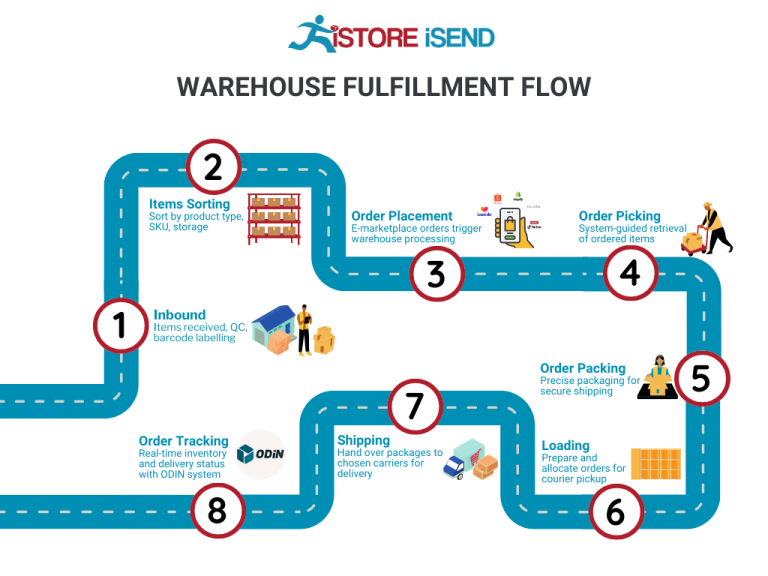
During this step, it’s essential to include packing slips, which provide details of the order and enhance the customer experience. Proper packing not only protects the products but also minimizes shipping costs by optimizing the package size. This phase is vital for maintaining product integrity and ensuring that customers receive their orders in excellent condition.
5. Shipping & Delivery
The final step in the order fulfillment process is shipping and delivery. Once orders are packed, they are labeled and sorted based on their destination. This process often involves collaboration with third-party carriers to ensure timely delivery. Key terms such as shipping zones and delivery windows come into play here, as they influence shipping costs and timelines.
Effective shipping strategies, including offering multiple shipping options and tracking capabilities, can significantly enhance the customer experience. Once the package is in transit, customers can track their orders, which fosters transparency and trust in the brand. This step is crucial for completing the customer journey, ensuring that products arrive at their doorsteps promptly and in perfect condition.
In summary, the order fulfillment process is a multi-step operation that requires careful coordination and attention to detail. Each stage, from receiving inventory to shipping and delivery, plays a significant role in ensuring customer satisfaction and operational efficiency. By optimizing these processes, e-commerce businesses can scale effectively and meet the demands of their growing customer base.
Comparing Fulfillment Models: In-House vs. 3PL vs. Dropshipping
Fulfillment Models Comparison
| Model | Who Handles Inventory | Best For (Business Stage) | Key Advantage | Key Disadvantage |
|---|---|---|---|---|
| In-House Fulfillment | Business owns and manages | Established businesses | Complete control over inventory and processes | High overhead costs and labor requirements |
| Third-Party Logistics (3PL) | External logistics provider | Growing to large businesses | Scalability and expertise in logistics | Less control over inventory and shipping |
| Dropshipping | Supplier | Startups or low-capital businesses | Low startup costs and no inventory management | Lower profit margins and dependency on suppliers |
In-House Fulfillment
In-house fulfillment refers to a model where businesses manage their own storage, inventory, and shipping processes. This approach is often utilized by established businesses that have the resources to maintain their own warehousing and logistics operations. The primary advantage of in-house fulfillment is the complete control it offers over inventory management and order fulfillment processes. Businesses can implement tailored processes that align with their brand, ensuring consistent customer experiences. However, this model comes with significant disadvantages, including high overhead costs related to warehouse space, equipment, and labor. Moreover, as order volumes fluctuate, maintaining an efficient workforce can be challenging, often leading to excess costs during slower periods. Businesses must also invest in technology and infrastructure to manage their operations effectively, which can be a barrier to entry for smaller enterprises.
Third-Party Logistics (3PL)
Third-party logistics (3PL) involves outsourcing logistics and fulfillment operations to specialized service providers. This model is ideal for businesses that are growing and looking to scale their operations without the burden of managing warehousing and shipping themselves. A key advantage of 3PL is the scalability it offers; businesses can easily adjust their logistics needs as they grow, tapping into the provider’s expertise and established networks. Additionally, 3PL providers often have advanced technology and systems in place, which can enhance efficiency and speed in order processing. However, the primary disadvantage is the reduced control over inventory and shipping processes. Businesses may face challenges in maintaining brand consistency and customer service levels, as they rely on external partners. Furthermore, the costs associated with 3PL services can accumulate, especially if businesses do not manage their logistics needs effectively.
Dropshipping
Dropshipping is a fulfillment model where retailers do not keep products in stock but instead transfer customer orders directly to suppliers, who then ship the products to the customer. This model is particularly well-suited for startups or businesses with limited capital since it eliminates the need for upfront inventory investment. The key advantage of dropshipping is the low barrier to entry; entrepreneurs can start selling a wide range of products without the financial risk associated with purchasing inventory. However, dropshipping comes with significant drawbacks, including lower profit margins due to reliance on suppliers for pricing and fulfillment. Additionally, businesses have little control over inventory levels, shipping times, and product quality, which can lead to customer dissatisfaction. The success of dropshipping largely depends on the reliability of suppliers and their ability to fulfill orders promptly and accurately, making it a less stable option for scaling operations compared to in-house fulfillment or 3PL solutions.
Conclusion
Choosing the right fulfillment model is a critical decision for e-commerce businesses, as it directly impacts operational efficiency, customer satisfaction, and ultimately, profitability. In-house fulfillment offers control but at a higher cost, while 3PL provides scalability and expertise, albeit with less control. Dropshipping presents a low-risk entry point for new businesses, but the trade-off is often lower margins and reliance on third-party suppliers. Business owners must carefully assess their current stage, resources, and long-term goals when determining the best fulfillment strategy to support their growth.
A Deep Dive into Amazon FBA: Pros, Cons, and Who It’s For
What is Fulfillment by Amazon (FBA)?
Fulfillment by Amazon (FBA) is a service provided by Amazon that allows e-commerce sellers to store their products in Amazon’s fulfillment centers. This service takes over the logistics of storage, packaging, and shipping, allowing sellers to focus more on their core business activities such as product sourcing and marketing. When a customer places an order for a product fulfilled by Amazon, the company handles the entire process from picking and packing the item to shipping it to the customer. This means that sellers can leverage Amazon’s vast distribution network and customer service resources.
With FBA, sellers also benefit from Amazon’s Prime program, giving their products eligibility for expedited shipping options, which can significantly increase sales potential. Additionally, sellers using FBA have their products listed with the “Fulfilled by Amazon” logo, which can enhance customer trust and confidence.
How FBA Works
-
Account Setup: Sellers begin by creating an Amazon seller account. Once set up, they can choose to enroll in the FBA program.
-
Inventory Preparation: Sellers prepare their products according to Amazon’s guidelines, which may include specific packaging and labeling requirements.
-
Shipping to Amazon: Sellers ship their inventory to Amazon’s fulfillment centers. Amazon provides shipping guidelines and can even assist in creating shipping plans.
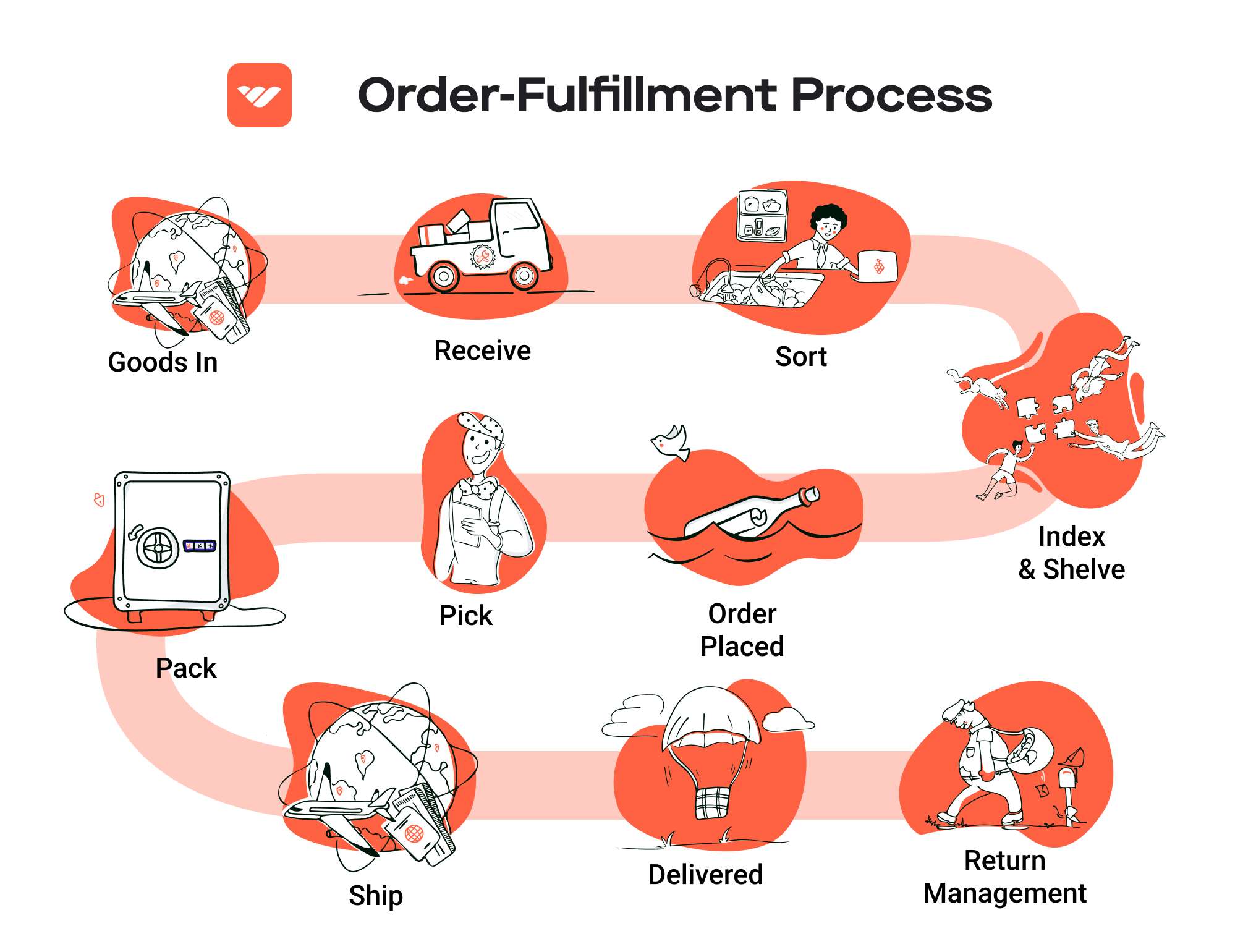
-
Storage: Once the products arrive at the fulfillment center, they are stored until sold. Sellers are charged storage fees based on the amount of space their inventory occupies.
-
Order Fulfillment: When a customer orders a product, Amazon picks, packs, and ships the item on behalf of the seller. Amazon also handles customer service and returns.
-
Payment: After the sale, Amazon deducts its fees and deposits the remaining balance into the seller’s account.
Pros of Using FBA
Prime Eligibility
One of the most significant advantages of FBA is the ability to offer products that are Prime eligible. This can lead to increased visibility and sales, as millions of Amazon Prime members prefer to shop for products that qualify for free two-day shipping.
Customer Trust
Products fulfilled by Amazon carry a level of trust that many independent sellers struggle to achieve. The “Fulfilled by Amazon” badge reassures customers about the reliability of the shipping and returns process, which can lead to higher conversion rates.
Multi-Channel Fulfillment
FBA allows sellers to fulfill orders not just on Amazon, but also on their own websites and other sales channels. This flexibility means that sellers can centralize their inventory management and logistics under one system.
Scalability
FBA enables sellers to scale their businesses quickly without the need for additional warehousing or logistics infrastructure. Amazon’s robust network can handle increased order volumes, allowing sellers to focus on growth.
Automated Customer Service
Amazon handles customer inquiries and returns for FBA products, freeing up sellers from day-to-day customer service responsibilities. This can be particularly advantageous for small business owners who may lack the resources for a dedicated customer service team.
Cons of Using FBA
High Fees
One of the main drawbacks of FBA is the cost structure. Sellers face various fees, including fulfillment fees per unit sold and monthly storage fees for inventory held in Amazon’s warehouses. These costs can add up quickly, particularly for lower-margin products.
Strict Inventory Rules
Amazon has stringent rules regarding inventory management, including requirements for how products must be packaged and labeled. Non-compliance can result in additional fees or inventory being returned to the seller.
Commingling Risks
FBA uses a system known as commingling, where inventory from multiple sellers of the same product may be stored together. This can lead to challenges if a seller receives negative reviews due to defects in another seller’s inventory. While Amazon has processes to manage this, it can still pose risks to a seller’s reputation.
Limited Control Over Fulfillment
When using FBA, sellers relinquish control over the fulfillment process. This means they cannot directly manage how orders are packed and shipped, which can lead to inconsistencies in customer experience.
Inventory Management Challenges
Sellers must carefully monitor their inventory levels to avoid overstocking, which incurs high storage fees, or understocking, which can lead to stockouts and missed sales opportunities. Additionally, seasonal fluctuations can complicate inventory management.
Who is FBA Best For?
FBA is an excellent solution for various types of sellers:
-
Small to Medium-Sized Businesses: Sellers looking to expand their reach without investing heavily in logistics and warehousing can benefit significantly from FBA.
-
E-commerce Entrepreneurs: Those launching new products can leverage Amazon’s infrastructure and customer base to gain traction quickly.
-
Brands with Established Products: Sellers with proven products looking to scale their operations can utilize FBA to handle increased order volumes seamlessly.
-
Multi-Channel Sellers: Businesses that sell across multiple platforms can streamline their fulfillment processes using FBA, allowing for consistent inventory management.
-
Sellers Focused on Customer Experience: Businesses that prioritize customer satisfaction and are willing to pay for enhanced service and trust can find FBA to be a valuable asset.
In summary, while FBA presents certain challenges, its advantages often outweigh the drawbacks for many sellers. It provides a robust platform for scaling an e-commerce business, especially for those focused on growth and customer satisfaction.
Core Services Offered by Fulfillment Centers
Inventory Management & Warehousing
Inventory management is a crucial aspect of any e-commerce operation, and fulfillment centers like Chewy’s MCO1 play a pivotal role in streamlining this process. Fulfillment centers provide dedicated warehousing space where products are stored until they are sold. This service includes real-time inventory tracking, ensuring that businesses always have an accurate count of their stock.
The benefits of effective inventory management are manifold. First, it minimizes the risk of stockouts or overstock situations, which can lead to lost sales or increased holding costs. With advanced inventory management systems, fulfillment centers can provide insights into inventory turnover rates, helping businesses make informed decisions about restocking and discontinuing products. Furthermore, efficient warehousing can enhance order accuracy, as products are organized systematically, making it easier to locate and retrieve items quickly. This leads to faster order fulfillment times, which is essential for maintaining customer satisfaction and loyalty.
Pick and Pack Services
Pick and pack services are at the heart of fulfillment operations. This process involves selecting products from the warehouse based on customer orders (the “pick”) and then packing them for shipment (the “pack”). Fulfillment centers utilize sophisticated technology and trained staff to ensure that this process is executed efficiently and accurately.
The benefits of pick and pack services are significant for e-commerce businesses. Firstly, it allows companies to scale their operations without needing to invest in additional labor or warehouse space. Fulfillment centers can handle fluctuations in order volume, especially during peak seasons. Additionally, outsourcing this function helps businesses focus on their core competencies, such as marketing and product development, rather than the logistics of order fulfillment. Fast and accurate pick and pack services also lead to improved customer experiences, as orders are processed and shipped swiftly, often resulting in higher customer retention and repeat purchases.
Kitting and Assembly
Kitting and assembly services involve combining multiple products into a single package or preparing items for sale in a specific configuration. This can include bundling related products together, creating gift sets, or assembling components into a final product. Fulfillment centers have the expertise and resources to handle these tasks efficiently.
For e-commerce businesses, kitting and assembly services offer several advantages. Firstly, they allow for greater customization of product offerings, enabling businesses to create unique bundles that appeal to specific customer segments. This can enhance the perceived value of the products and potentially increase average order values. Moreover, outsourcing kitting and assembly to a fulfillment center reduces the burden on internal resources, allowing businesses to focus on strategic initiatives rather than operational details. Additionally, by leveraging the expertise of fulfillment centers, companies can ensure that kitted products are packaged professionally, which can enhance brand image and customer satisfaction.
Returns Management (Reverse Logistics)
Returns management, often referred to as reverse logistics, is an essential service provided by fulfillment centers. This process involves handling returned products, assessing their condition, restocking items, and managing exchanges or refunds. Effective returns management can significantly impact customer satisfaction and retention.
For e-commerce businesses, the benefits of streamlined returns management are substantial. First, it creates a hassle-free experience for customers, encouraging them to make purchases with confidence, knowing that they can return items easily if necessary. This is particularly important in the e-commerce space, where customers may hesitate to buy products they cannot physically inspect beforehand. Additionally, efficient returns processing helps businesses recover value from returned goods, whether by restocking sellable items or refurbishing damaged products for resale. By utilizing fulfillment centers for returns management, e-commerce businesses can also gain valuable insights into customer preferences and product performance, allowing them to make data-driven decisions about inventory and product offerings.
In conclusion, partnering with a fulfillment center like Chewy’s MCO1 can provide e-commerce businesses with critical operational advantages. From efficient inventory management and reliable pick and pack services to customizable kitting and effective returns management, these services help streamline logistics, enhance customer satisfaction, and ultimately drive growth. By leveraging the expertise and resources of fulfillment centers, e-commerce businesses can focus on scaling their operations while ensuring a seamless experience for their customers.
How to Choose a Fulfillment Partner: A 6-Point Checklist
Location & Warehouse Network
Choosing a fulfillment partner with strategically located warehouses is crucial for timely delivery and reduced shipping costs. A partner’s warehouse network should align with your target markets to ensure efficient distribution.
Why It Matters:
Proximity to your customers can significantly impact shipping times and costs. If your fulfillment partner is located far from your primary customer base, you may face longer lead times and higher shipping fees, which can affect customer satisfaction.
Questions to Ask:
– Where are your fulfillment centers located, and how many do you operate?
– How do you determine the best shipping options for different regions?
– Can you accommodate international shipping, and what are the associated costs and logistics?
Technology & Integrations
A fulfillment partner’s technology capabilities can streamline operations and enhance customer experience. Look for partners that offer robust systems for order management, inventory tracking, and reporting.
Why It Matters:
Effective technology ensures real-time visibility into your inventory and order status, enabling better decision-making and customer communication. Seamless integration with your existing e-commerce platform can also reduce manual work and errors.
Questions to Ask:
– What fulfillment technology do you use, and how does it integrate with popular e-commerce platforms?
– Do you offer real-time inventory tracking, and how can I access this data?
– How frequently do you update your technology, and are there any upcoming enhancements?
Specializations (e.g., Cold Storage, Oversized Items)
Different businesses have unique fulfillment needs. If you sell specialized products like perishables or oversized items, ensure your partner has the capabilities to handle these requirements.
Why It Matters:
Specialized fulfillment processes can significantly affect product integrity and customer satisfaction. For example, cold storage is essential for perishable goods, while oversized items may require special handling and shipping solutions.
Questions to Ask:
– Do you have specialized facilities or equipment for handling specific types of products?
– What processes do you have in place to ensure product quality during storage and shipping?
– Can you provide examples of how you have successfully managed specialized fulfillment needs for other clients?
Scalability & Capacity
As your business grows, your fulfillment needs will evolve. A good partner should be able to scale operations to meet increasing demand without sacrificing service quality.
Why It Matters:
Choosing a partner that can grow with you helps prevent disruptions in service and ensures that you can meet customer expectations during peak seasons or unexpected spikes in demand.
Questions to Ask:
– What is your current capacity for handling orders, and how do you plan to scale as demand increases?
– Have you previously managed seasonal spikes in volume? If so, how did you handle it?
– What contingency plans do you have in place to ensure service continuity during unexpected surges in demand?
Pricing and Contracts
Understanding the pricing structure and contract terms is vital for maintaining profitability. Look for transparency in pricing and ensure that you are aware of all potential fees.
Why It Matters:
Hidden fees or unfavorable contract terms can erode your profit margins. A clear understanding of costs associated with storage, order fulfillment, shipping, and returns will help you make informed financial decisions.
Questions to Ask:
– Can you provide a detailed breakdown of your pricing structure?
– What additional fees should I be aware of, such as for storage, order processing, or returns?
– Are there long-term contracts, and what are the terms for termination or scaling services up or down?
Customer Support & Reviews
The level of customer support your fulfillment partner provides is critical, especially when issues arise. Researching reviews can give insight into their reputation and reliability.
Why It Matters:
Strong customer support can mitigate problems quickly and effectively. Additionally, positive reviews from other businesses can indicate a partner’s reliability and service quality.
Questions to Ask:
– What kind of customer support do you offer? Is it available 24/7?
– How do you handle issues or discrepancies in order fulfillment?
– Can you provide references or case studies from clients with similar needs to mine?
Conclusion
Selecting the right fulfillment partner is a pivotal decision that can significantly impact your e-commerce operations. By carefully evaluating these six key points—location and warehouse network, technology and integrations, specializations, scalability and capacity, pricing and contracts, and customer support—you can make an informed choice that aligns with your business goals and enhances customer satisfaction. Always conduct thorough research and consider potential partners’ capabilities to ensure they can meet your unique fulfillment needs as you scale your business.
Understanding Fulfillment Pricing: A Breakdown of Common Fees
Initial Setup Fees
When partnering with a fulfillment center, businesses often encounter initial setup fees. These fees cover the cost of integrating your e-commerce platform with the fulfillment center’s systems, including inventory management and order processing software. The setup process may also involve creating your product listings, configuring shipping methods, and establishing protocols for returns and customer service.
The calculation of initial setup fees can vary widely based on the complexity of your operations. Factors influencing these costs include the number of SKUs (stock keeping units) you need to set up, the level of customization required, and whether the fulfillment center offers ongoing technical support. Businesses can expect to pay anywhere from a few hundred to several thousand dollars, depending on these variables.
Receiving Fees
Receiving fees are charged when the fulfillment center accepts and processes incoming inventory shipments. This fee covers the labor and resources required to unload, inspect, and store your products. The receiving process typically includes verifying the quantity and condition of items against your purchase order and updating the inventory management system accordingly.
These fees can be calculated on a per-pallet or per-box basis. For instance, a fulfillment center may charge a flat rate for each pallet received, which can range from $20 to $50, or charge based on the number of boxes, with rates typically between $1 and $5 per box. It’s essential to clarify how receiving fees are structured with your chosen fulfillment center to avoid unexpected costs.
Storage Fees (per pallet/bin)
Storage fees are incurred for the space your inventory occupies within the fulfillment center. These fees are usually assessed monthly and can be calculated based on the number of pallets or bins your products occupy. Fulfillment centers may charge a flat monthly rate per pallet or a variable rate based on the total volume of space used.
For example, a center might charge $10 to $25 per pallet per month, while bin storage could be charged at a lower rate, such as $5 to $15 per bin. It’s crucial to estimate your inventory turnover rates accurately; slower-moving products may lead to higher storage costs, prompting you to optimize your stock levels or negotiate better terms with your fulfillment partner.
Pick & Pack Fees (per item/order)
Pick and pack fees are charged for the labor involved in selecting items from inventory and preparing them for shipment. This process includes picking the ordered items, packing them into boxes, and labeling them for delivery. The fees can be structured in different ways: per item picked, per order processed, or a combination of both.
Commonly, fulfillment centers might charge anywhere from $0.50 to $2.00 per item for picking, and an additional fee for packing, which can range from $1.00 to $3.00 per order. Understanding your average order size and frequency can help you estimate these costs accurately and negotiate terms that align with your business needs.
Shipping Fees
Shipping fees are one of the most significant costs associated with fulfillment. These fees cover the transportation of your products from the fulfillment center to the customer. Shipping costs can vary based on several factors, including the destination, package dimensions, weight, and chosen shipping method (standard, expedited, etc.).
Fulfillment centers often have relationships with various carriers, allowing them to offer competitive shipping rates. Businesses should inquire about how shipping fees are calculated—whether they are passed through at cost, marked up, or discounted based on volume. Additionally, understanding the fulfillment center’s shipping policies, such as free shipping thresholds or discounted rates for bulk orders, can help manage these expenses effectively.
Tips for Getting an Accurate Quote
-
Provide Detailed Information: When seeking quotes from fulfillment centers, provide comprehensive details about your business model, including the types of products, order volumes, and any special handling requirements.
-
Understand the Fee Structure: Ask for a breakdown of all potential fees, including initial setup, receiving, storage, pick & pack, and shipping. This will help you compare different fulfillment centers accurately.
-
Consider Seasonal Variability: Factor in seasonal fluctuations in order volume, as this can impact storage and pick & pack fees. Discuss how these fees may change during peak seasons.
-
Negotiate Terms: Don’t hesitate to negotiate fees or seek volume discounts, especially if you expect to scale your operations. Many fulfillment centers are willing to adjust their pricing to secure long-term partnerships.
-
Request a Trial Period: If possible, ask for a trial period to evaluate the fulfillment center’s services and costs before committing to a long-term contract. This can provide valuable insights into actual operational costs.
By understanding these common fulfillment pricing models and following these tips, e-commerce businesses can better manage their logistics costs and make informed decisions that support their growth and profitability.
Frequently Asked Questions (FAQs) about Fulfillment
1. What is Chewy Fulfillment Center MCO1?
Chewy Fulfillment Center MCO1 is one of Chewy’s key distribution centers that plays a vital role in the company’s supply chain. Located in Ocala, Florida, this facility is designed to efficiently manage the storage, packing, and shipping of pet supplies to customers across the country, ensuring timely delivery and high customer satisfaction.
2. How does Chewy’s fulfillment process work?
The fulfillment process at Chewy involves several steps: receiving inventory, storing products in organized shelving, picking items based on customer orders, packing them securely, and finally shipping them to the customer. Advanced technology and trained personnel ensure that this process is streamlined for efficiency and accuracy.
3. What is the difference between a warehouse and a fulfillment center?
A warehouse is primarily used for storing goods until they are needed, while a fulfillment center focuses on the entire order processing system, including inventory management, order picking, packing, and shipping. Fulfillment centers are designed for high turnover and fast shipping, making them crucial for e-commerce businesses.
4. What is a 3PL (Third-Party Logistics)?
A 3PL, or Third-Party Logistics provider, is a company that offers outsourced logistics services to businesses. This can include transportation, warehousing, and fulfillment services. Partnering with a 3PL can help e-commerce businesses scale their operations without the need for significant investments in infrastructure.
5. How much do fulfillment services cost?
The cost of fulfillment services can vary widely based on several factors, including the volume of orders, the size and weight of products, storage fees, and the specific services required (like packaging and shipping). Typically, businesses can expect to pay a per-order fee, storage fees, and additional costs for value-added services. It’s important to obtain quotes from multiple providers to find the best fit for your needs.
6. What technologies does Chewy use in its fulfillment centers?
Chewy employs advanced technologies such as automated inventory management systems, robotics for picking and packing, and data analytics tools to optimize operations. These technologies help streamline processes, reduce errors, and enhance overall efficiency in fulfilling customer orders.
7. How does Chewy ensure fast shipping times?
Chewy ensures fast shipping times by strategically locating its fulfillment centers, such as MCO1, near major customer bases, optimizing its inventory management systems, and employing efficient picking and packing processes. This allows for quicker turnaround times from order placement to delivery.
8. Can small businesses use Chewy’s fulfillment services?
Yes, Chewy’s fulfillment services are accessible to businesses of various sizes, including small businesses. By leveraging Chewy’s infrastructure, small businesses can scale their operations and provide customers with efficient shipping solutions without needing to manage their own fulfillment processes.
9. How does Chewy handle returns?
Chewy has a customer-friendly return policy that allows customers to initiate returns easily. The fulfillment center processes returned items efficiently, ensuring that they are restocked or handled according to company policies. Clear communication with customers regarding return instructions is also a key part of their service.
10. What are the benefits of using Chewy’s fulfillment services?
Using Chewy’s fulfillment services offers several benefits, including access to a vast network of distribution centers, expertise in logistics and supply chain management, fast shipping capabilities, and the ability to focus on core business activities while Chewy handles order fulfillment. This allows businesses to enhance customer satisfaction and potentially increase sales.
Conclusion: Is Outsourcing Fulfillment the Right Move for Your Business?
Evaluating the Advantages of Outsourcing Fulfillment
Outsourcing fulfillment can be a game-changer for e-commerce businesses looking to scale efficiently. One of the primary benefits is the significant time savings it offers. By partnering with a fulfillment center, such as Chewy’s, you can redirect your focus from the complexities of logistics to core business strategies, product development, and customer engagement. This allows you to enhance your brand presence and improve customer experiences without being bogged down by daily operational challenges.
Scalability is another critical advantage. As your business grows, so too does the complexity of your fulfillment needs. A capable fulfillment partner can provide the infrastructure and resources necessary to handle increased order volumes seamlessly. This flexibility ensures that you can respond to market demands without the need for hefty upfront investments in warehousing and personnel.
Moreover, expertise plays a pivotal role in the success of your fulfillment operations. Established fulfillment centers have refined processes, advanced technologies, and experienced teams that can optimize order accuracy and speed. By leveraging this expertise, you can improve your operational efficiency and maintain a competitive edge in the market.
However, the choice of the right fulfillment partner is crucial. Not all providers are created equal, and selecting one that aligns with your business goals and values can significantly impact your growth trajectory.
Next Steps for Your Business
To determine if outsourcing fulfillment is the right move for your business, conduct a thorough audit of your current shipping and logistics processes. Assess your pain points, analyze your order volume, and evaluate your growth potential. This strategic reflection will help you identify whether a fulfillment partner could enhance your operational efficiency and support your scaling efforts. Take the time to explore potential partners and ensure they can meet your unique needs, paving the way for sustainable growth and success.
Important Disclaimer
⚠️ Important Disclaimer
The information in this guide is for educational purposes. Fulfillment services, pricing, and platform features change frequently. Always conduct your own due diligence and consult with providers directly before making business decisions.
